Complete Solutions to Part-I of chapter CARBONYL COMPOUNDS (ALDEHYDES & KETONES ) & CARBOXYLIC ACID of Class 12 book with complete answers and questions
| Class 12 | CHEMISTRY |
| Chapter | CARBONYL COMPOUNDS (ALDEHYDES & KETONES ) & CARBOXYLIC ACID |
| RESONANCE NEW | Part-I |
| Number Of Questions | 97 |
| Academic Year | 2023-24 |
 View Solution
View Solution`Ph-CH=CH-underset(O)underset(C)-H overset((i) CH_(3)CH_(2)MgBr)to overset((ii) H_(3)O^(o+))to(X) overset(Cu,Delta)to(Y)`
View SolutionConsider the following sequence of reactions

The product (A) and (B) are, respectively :04:19View SolutionIn the given reaction sequence B is
 View Solution
View Solution
The reactant (A) will be :View Solution`CH_(3)overset(O)overset(||)(C)CH_(2) overset(CH_(3))overset(|)underset(CH_(3))underset(|)(C)CHO overset(KOH,H_(2)O)underset(Delta)to` product `(C_(7)H_(10)O)` :
View Solution 03:10View Solution
03:10View SolutionThe suitable reagent for the following reactions is
 View Solution
View Solution View Solution
View Solution (mixture of alkenes) `overset((i) O_(3))underset((ii) Zn//H_(2)O)to` (mixture of carbonyl compounds). The incorrect statement is 10:26View Solution
(mixture of alkenes) `overset((i) O_(3))underset((ii) Zn//H_(2)O)to` (mixture of carbonyl compounds). The incorrect statement is 10:26View SolutionWhat is the product of this sequence of reactions ?
 View Solution
View Solution Product B is : 03:49View Solution
Product B is : 03:49View Solution View Solution
View SolutionIn the following reaction, A+B

A and B respectively are :View SolutionAromatic carbonyl compound having molecular formula `C_(8)H_(8)O` react with `NH_(2)OH` how many oximes can be formed
07:14View Solution Products with stereochemical relation View Solution
Products with stereochemical relation View SolutionWhich of the following does not give benzoic acid on hydrolysis ?
01:26View SolutionIdentify the final product in the following sequence of reaction.
 01:58View Solution
01:58View Solution 03:13View Solution
03:13View Solution`CH_(3)CH_(2)CH_(2)CONH_(2)` is boiled with aqueous NaOH, then the reaction mixture is acidified with HCl. The products obtained are
View SolutionIn how many steps decarboxylation reaction is taking place
 04:13View Solution
04:13View SolutionAn alkene (A) `C_(16)H_(16)` on ozonolysis gives only one product (B) `C_8H_8O`. Compound (B) on reaction with NaOH/`I_(2)` yeilds sodium benzoate. Compound (B) reacts with KOH/`NH_(2)NH_(2)` yielding a hydrocarbn (C)`C_(8)H_(10)`. Write the structure of compound (B) and (C). based on this information to isomeric structures can be proposed for alkene (A). write their structure and identify the isomer which one catalytic hydrogenation `(H_(2)//Pd-C)` gives a racemic mixture
View SolutionCompound 'A' (molecular formula `C_(3)H_(8)O`) is treated with acidified potassium dichromate to form a product 'B' (molecular formula `C_(3)H_(6)O`)'B' forms a shining silver mirror on warming with ammoniacal silver nitrate 'B' when treated with an aqueous solution of `H_(2)NCONHNH_(2)` and sodium acetate gives a product 'C'. Identify the structure of 'C'
05:40View Solution View Solution
View Solution`A(C_(6)H_(12))overset(HCl)to underset((C_(6)H_(13)C))(B+C)`
`B overset(alc KOH)toD` (isomer of A)
`D overset("ozonolysis")toE` (it gives negative test with Fehling solution but responds to iodoform test).
`A overset("ozolysis")toF+G` (Both give positive Tollen's but do not give iodoform test)
`F+G overset("conc. NaOH")to` HCOONa +a primary alcohol
Identify to A to GView SolutionIn the following reaction
 04:52View Solution
04:52View SolutionIn conversion of 2-butanone to propanoic acid which reagent is used
View Solution
Identify (X) and (Y).05:54View SolutionWhich of the following reactants on reaction with conc. NaOH followed by acidification gives following lactone as the product?
 03:09View Solution
03:09View SolutionCyclohexene on ozonolysis followed by reaction with zinc dust and water gives compound E. Compound E on furhter treatment with aqueous KOH yields compound F. Compound F is
04:31View SolutionA tertiary alcohol (H) upon acid-catalysed dehydration gives a product (I). Ozonolysis of (I) leads to compounds (J) and (K). Compound (J) upon reaction with KOH gives benzyl alcohol and a compound (L), whereas (K) on reaction with KOH gives only (M).

Compound (H) is formed by the reaction of:09:19View SolutionA tertiary alcohol (H) upon acid-catalysed dehydration gives a product (I). Ozonolysis of (I) leads to compounds (J) and (K). Compound (J) upon reaction with KOH gives benzyl alcohol and a compound (L), whereas (K) on reaction with KOH gives only (M).
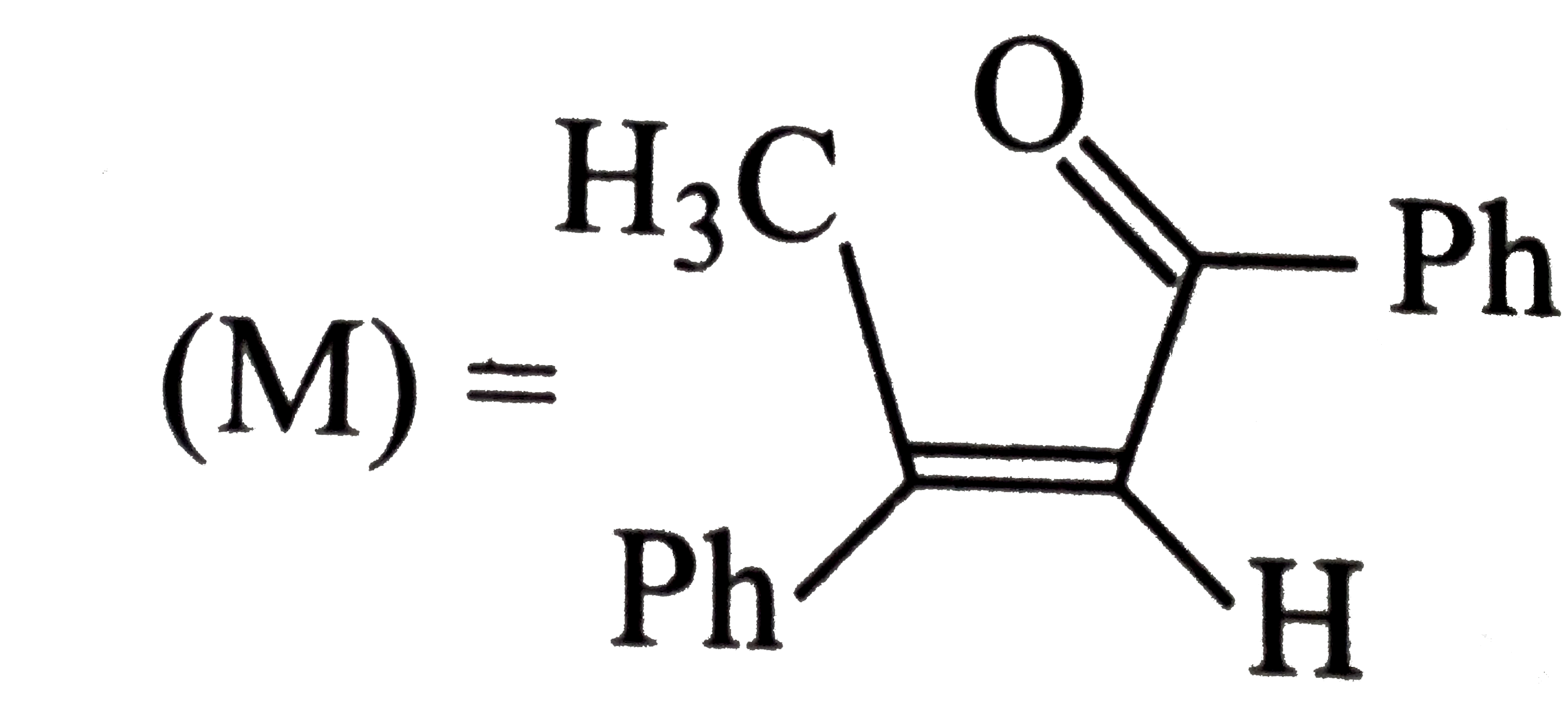
The structurer of compound (I) is:09:19View SolutionA tertiary alcohol (H) upon acid-catalysed dehydration gives a product (I). Ozonolysis of (I) leads to compounds (J) and (K). Compound (J) upon reaction with KOH gives benzyl alcohol and a compound (L), whereas (K) on reaction with KOH gives only (M).
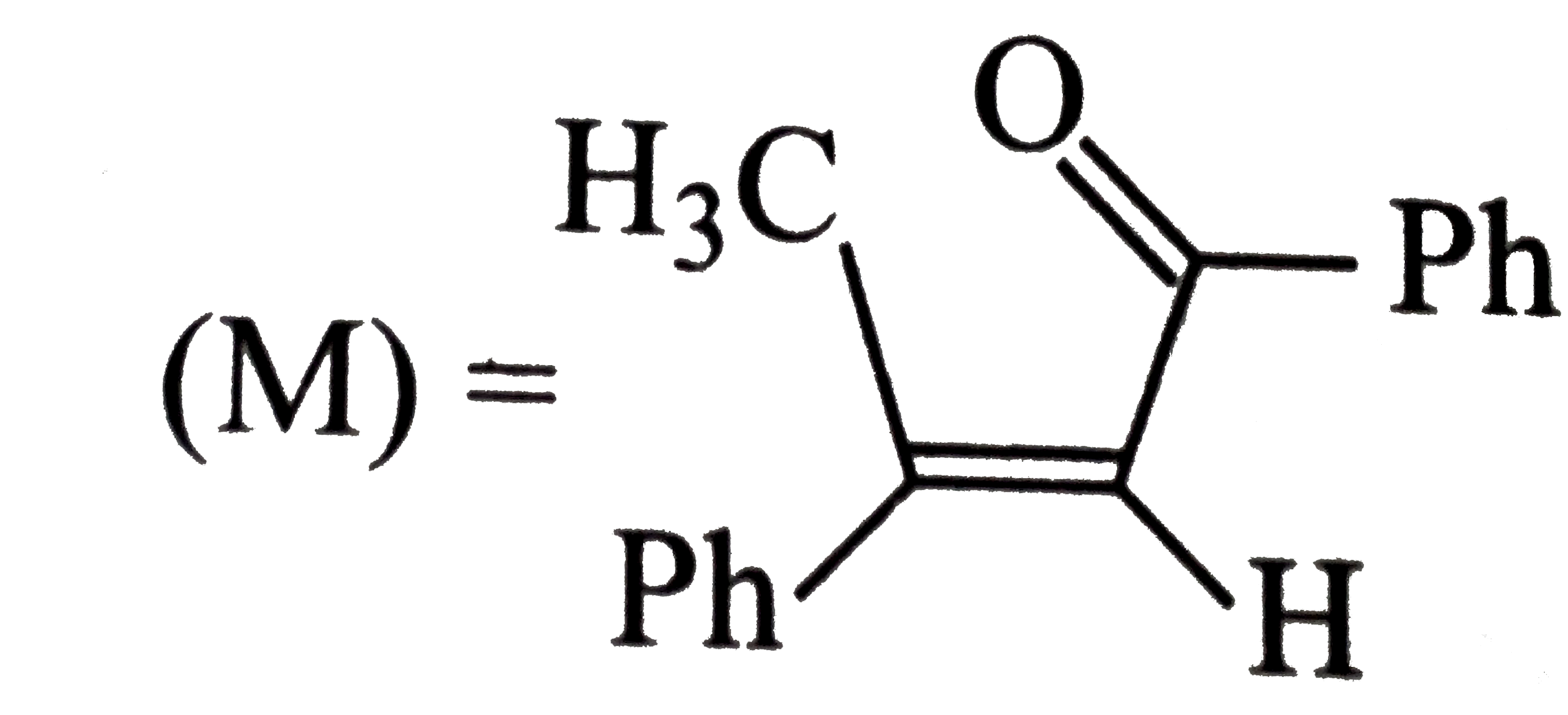
The structures of compounds (J), (K), and (L), respectively, are:09:19View SolutionA carbonyl compound (P) which gives positive iodoform test, undergoes reaction with MeMgBr followed by dehydration to give an olefin (Q). Ozonolysis of (Q) leads to a dicarbonyl compound (R ) which undergoes intramolecular aldol reaction to give predominantly (S).
`Poverset(1. MeMgBr)underset{:(2.H^(+)","H_(2)O),(3.H_(2)SO_(4)","Delta):}rarr Q underset(2. Zn"," H_(2)O)overset(1. O_(3))rarr R underset(2. Delta)overset(1. OH^(-))rarr S`
The structure of the carbonyl compound (P) is:11:36View SolutionA carbonyl compound (P) which gives positive iodoform test, undergoes reaction with MeMgBr followed by dehydration to give an olefin (Q). Ozonolysis of (Q) leads to a dicarbonyl compound (R ) which undergors intramolecular aldol reaction to give predominantly (S).
`Poverset(1. MeMgBr)underset{:(2.H^(+)","H_(2)O),(3.H_(2)SO_(4)","Delta):}rarr Q underset(2. Zn"," H_(2)O)overset(1. O_(3))rarr R underset(2. Delta)overset(1. OH^(-))rarr S`
The structure of products (Q) and (R ), respectively, are:11:36View SolutionA carbonyl compound (P) which gives positive iodoform test, undergoes reaction with MeMgBr followed by dehydration to give an olefin (Q). Ozonolysis of (Q) leads to a dicarbonyl compound (R ) which undergors intramolecular aldol reaction to give predominantly (S).
`Poverset(1. MeMgBr)underset{:(2.H^(+)","H_(2)O),(3.H_(2)SO_(4)","Delta):}rarr Q underset(2. Zn"," H_(2)O)overset(1. O_(3))rarr R underset(2. Delta)overset(1. OH^(-))rarr S`
The structure of product (S) is:11:36View SolutionMatch each of the compounds given in ColumnI with reaction (s) that they can undergo, given in Column II.
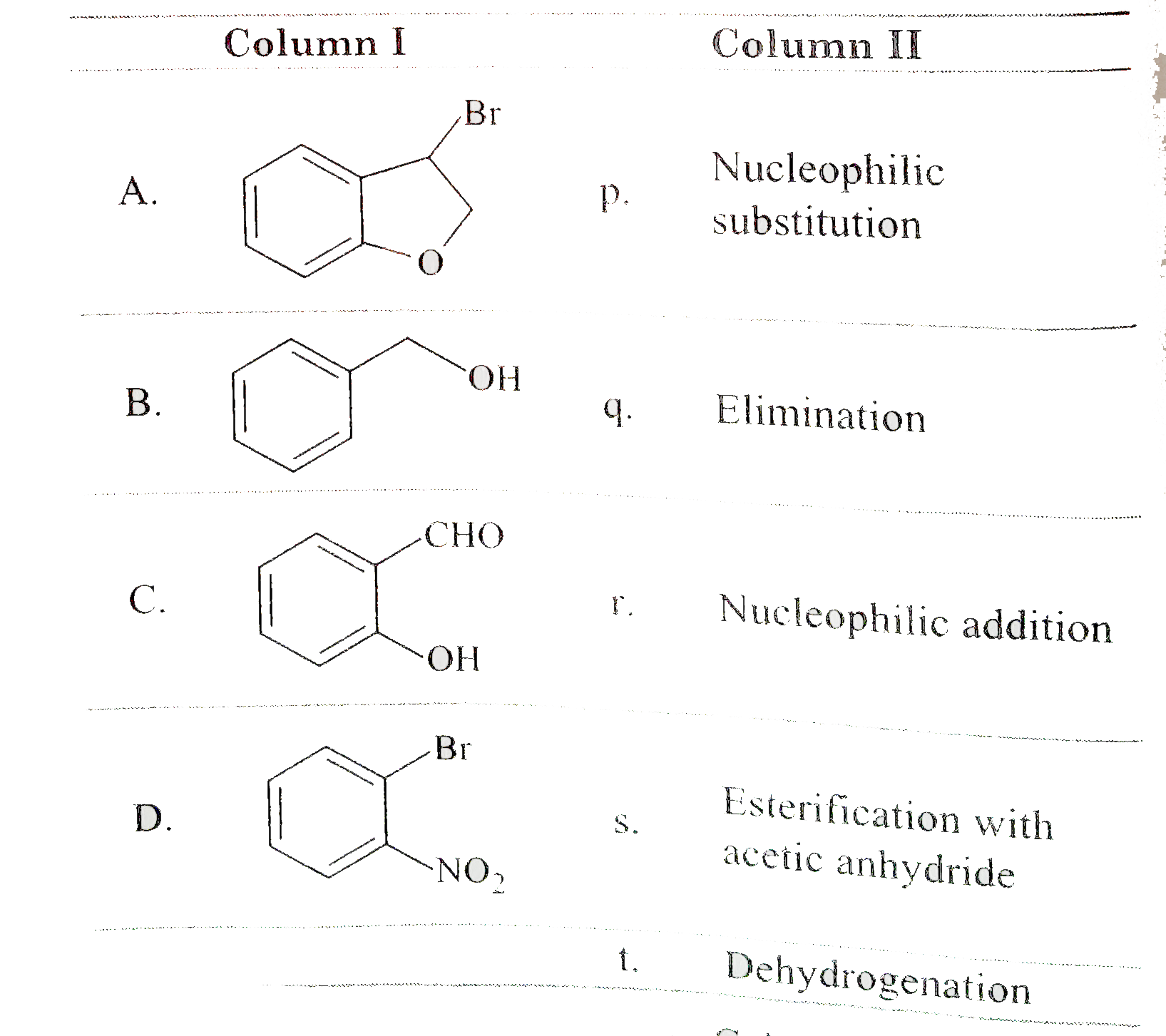 05:55View Solution
05:55View SolutionIn the scheme given below, the total number of intramolecular aldol condensation products formed from (Y) is
 03:59View Solution
03:59View SolutionTwo aliphatic aldehydes (P) and (Q) react in the presence of aqueous `K_(2)CO_(3)` to give compound (R ) which upon treatment with HCN gives compound(S). On acidification and heating, (S) gives the product shown below:

Compounds (P) and (Q), respectively, are:06:56View SolutionTwo aliphatic aldehydes (P) and (Q) react in the presence of aqueous `K_(2)CO_(3)` to give compound (R ) which upon treatment with HCN gives compound(S). On acidification and heating, (S) gives the product shown below:

Compound (R ) is:06:56View SolutionTwo aliphatic aldehydes P and Q react in th presence of aqueous `k_(2)CO_(3)` to give compound R, which upon treatment with HCN provides compound S. On acidification and heatingm,S gives the product shown below:

The compound S is11:01View SolutionMatch the reactions in Column I with appropriate types of steps/reactive intermediate involved in these reactions as given in Column II.
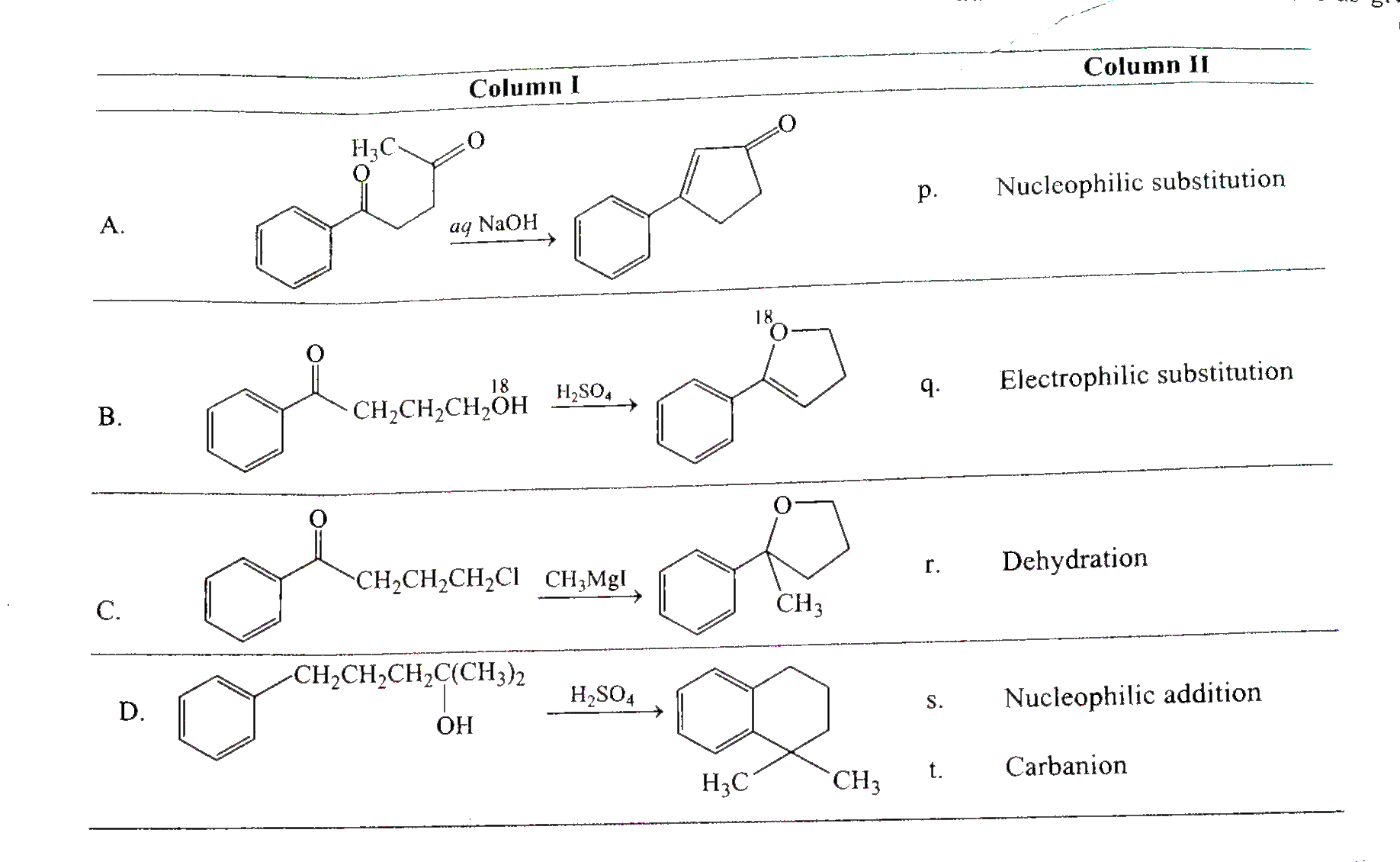 08:54View Solution
08:54View SolutionGive the mechanisms of aldol reaction (s) that occurs in the following transformation
 04:41View Solution
04:41View SolutionIn the following reaction sequence, the compound J is an
interemediate
`Iunderset(CH_(3)COONa)overset((CH_(3)CO)_(2)O)(to)J underset({:((ii)SOCl_(2)),((iii)"anhyd".AlCl_(3)):})overset((i)H_(2),Pd//C)(to)K`
`J(C_(9)H_(8)O_(2))` gives effervsecence on the treament with` NaHCHO_(3)`
and positive Baeyr's test.
The compound K, is08:59View SolutionIn the following reaction sequence, the compound J is an
interemediate
`Iunderset(CH_(3)COONa)overset((CH_(3)CO)_(2)O)(to)J underset({:((ii)SOCl_(2)),((iii)"anhyd".AlCl_(3)):})overset((i)H_(2),Pd//C)(to)K`
`J(C_(9)H_(8)O_(2))` gives effervsecence on the treament with` NaHCHO_(3)`
and positive Baeyr's test.
The compound I , is08:59View SolutionAfter completion of the reactions (I and II ), the organic compound (s) in the reactions mixtures is (are )
 View Solution
View SolutionAmong P, Q, R and S, the aromatic compounds(s) is/are
 06:31View Solution
06:31View SolutionThe major product of the following reactions is
 04:26View Solution
04:26View SolutionIn the following reactions, the product S is
 View Solution
View SolutionThe major product of the following reactions sequence is
 View Solution
View SolutionPositive Tollen's test is observed for
View SolutionCompounds P and R upon ozonolysis produce Q and S, respectively. The molecular formula of Q and S is `C_(8)H_(8)O`. Q undergoes cannizzaro reactions but not haloform reaction. Whereas S undergoes haloform reactions but not cannizzaro reactions.
(i) P `overset((i) O_(3)//CH_(2)Cl_(2))underset((ii)Zn//H_(2)O)tounderset((C_(8)H_(8)O))(Q) " " (ii) R overset((i) O_(3)//CH_(2)Cl_(2))underset((ii) Zn//H_2O)tounderset((C_(8)H_(8)O))(S)`
The option (s) with suitable combination of P and R , respectively is (are)View SolutionThere is a solution of p-hydroxybenzoic acid and p-amino benzonoc acid. Discuss one method by which we can separate them and also write down the confirmatory test of the functional group present.
03:16View Solution`Ph-underset(O)underset(||)(C)-NH_(2) overset(POCl_(3))to` products is
View SolutionIdentify the structure of the major products A,B, C and D formed in the following sequence of reactions
 View Solution
View SolutionIn the following reactions sequence, the correct structures of E,F and G are
 03:17View Solution
03:17View SolutionIn the reaction
 the structures of the product T is 03:58View Solution
the structures of the product T is 03:58View SolutionThe carboxyl functional group (-COOH) is present in
02:27View SolutionThe compound that undergoes decarboxylation most readily under mild condition is
02:08View SolutionThe major product H in the given reaction sequence is
`CH_(3)-CH_(2)-CO-CH_(3) overset(._(Theta)CN)toG overset(95% H_(2)SO_(4)) underset("Heat")toH`04:10View SolutionThe total number of carboxylic acid groups in the product P is
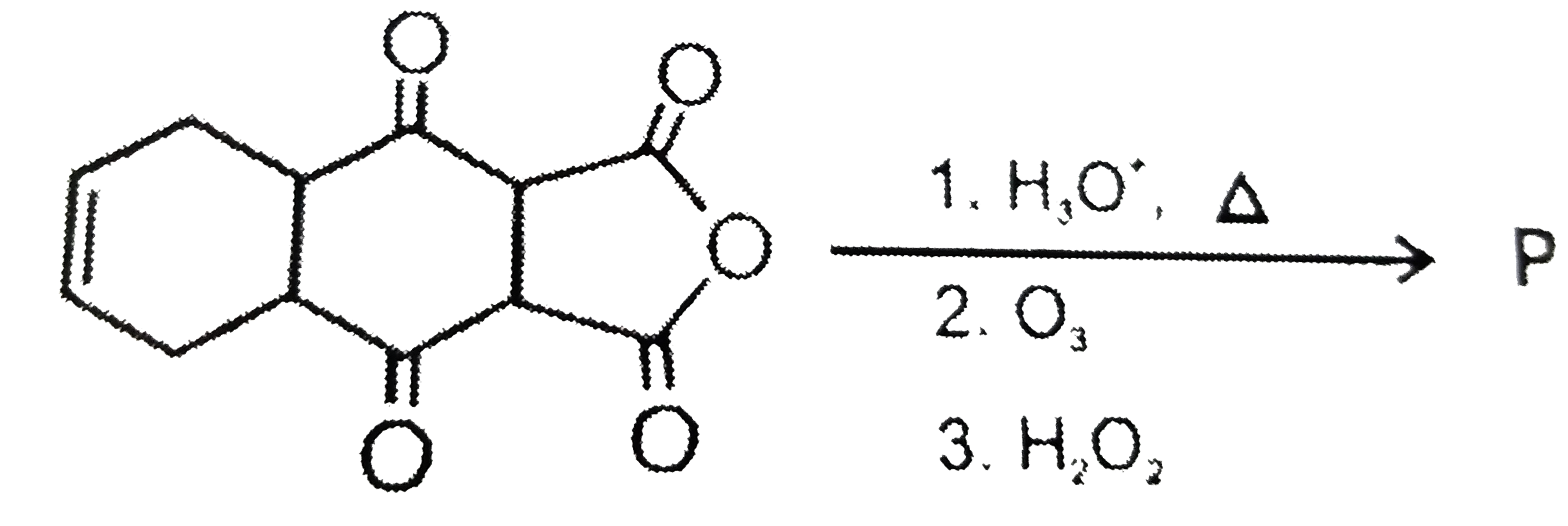 04:06View Solution
04:06View Solution
The only CORRECT combination in which the reaction
proceeds through radical mechanism is03:20View SolutionColumn 1,2 and 3 contain starting materials, reaction conditions, and type of reactions, respectively

For the synthesis of benzoic acid, the only CORRECT combination isView SolutionColumn 1,2 and 3 contain starting materials, reaction conditions, and type of reactions, respectively

The only CORRECT combination that gives two different carboxylic acid isView SolutionTreatment of benzene with CO/HCl in the presence of anhydrous `"AlCl"_(3)//"CuCl" ` followed by reaction with `Ac_(2)"O"//"NaOAc"` gives compound X as the major product. Compound X upon reaction with `Br_(2)//Na_(2)CO_(3)`, followed by heating at 473 K with moist KOH furnishes Y as the major product. Reaction of X with `H_(2)//Pd-C`, followed by `H_(3)PO_(4)` treatment gives Z as the major product.
The compound Y is06:35View SolutionTreatment of benzene with CO/HCl in the presence of anhydrous `"AlCl"_(3)//"CuCl" ` followed by reaction with `Ac_(2)"O"//"NaOAc"` gives compound X as the major product. Compound X upon reaction with `Br_(2)//Na_(2)CO_(3)`, followed by heating at 473 K with moist KOH furnishes Y as the major product. Reaction of X with `H_(2)//Pd-C`, followed by `H_(3)PO_(4)` treatment gives Z as the major product.
The compound Z is06:35View SolutionAn organic acid P `(C_(11)H_(12)O_(2))` can easily be oxidized to a dibasic acid which reacts with ethyleneglycol to produce a polymer dacron. Upon ozonolysis, P gives an aliphatic ketone as one of the products. P undergoes the following reaction sequences to furnish R via Q. The compound P also undergoes another set of reactions to produce S.
The compound R is12:20View SolutionAn organic acid P `(C_(11)H_(12)O_(2))` can easily be oxidized to a dibasic acid which reacts with ethyleneglycol to produce a polymer dacron. Upon ozonolysis, P gives an aliphatic ketone as one of the products. P undergoes the following reaction sequences to furnish R via Q. The compound P also undergoes another set of reactions to produce S.
The compound S is12:20View SolutionWhich of the following will be products of following reaction ?
 View Solution
View SolutionUnder Wolff Kishner reduction conditions, the conversions which may be brought about is
03:25View SolutionAn organic compoun having molecular formula `C_(3)H_(6)O` does not react with 2,4-dintrophenol hydrazine and does not react Na metal. The compound is expected to be:
02:45View SolutionIn the given reaction sequence
`Ph-CH_(2)-CHO overset(NaOH)to overset(Delta)to overset(H_(2)//Ni)to`(X)
Product (X) will be03:11View SolutionAmong the following compounds which one will react with acetone to give a product containing a carbon-nitrogen double bond ?
01:47View SolutionConsider following intramolecular aldol condensation reaction
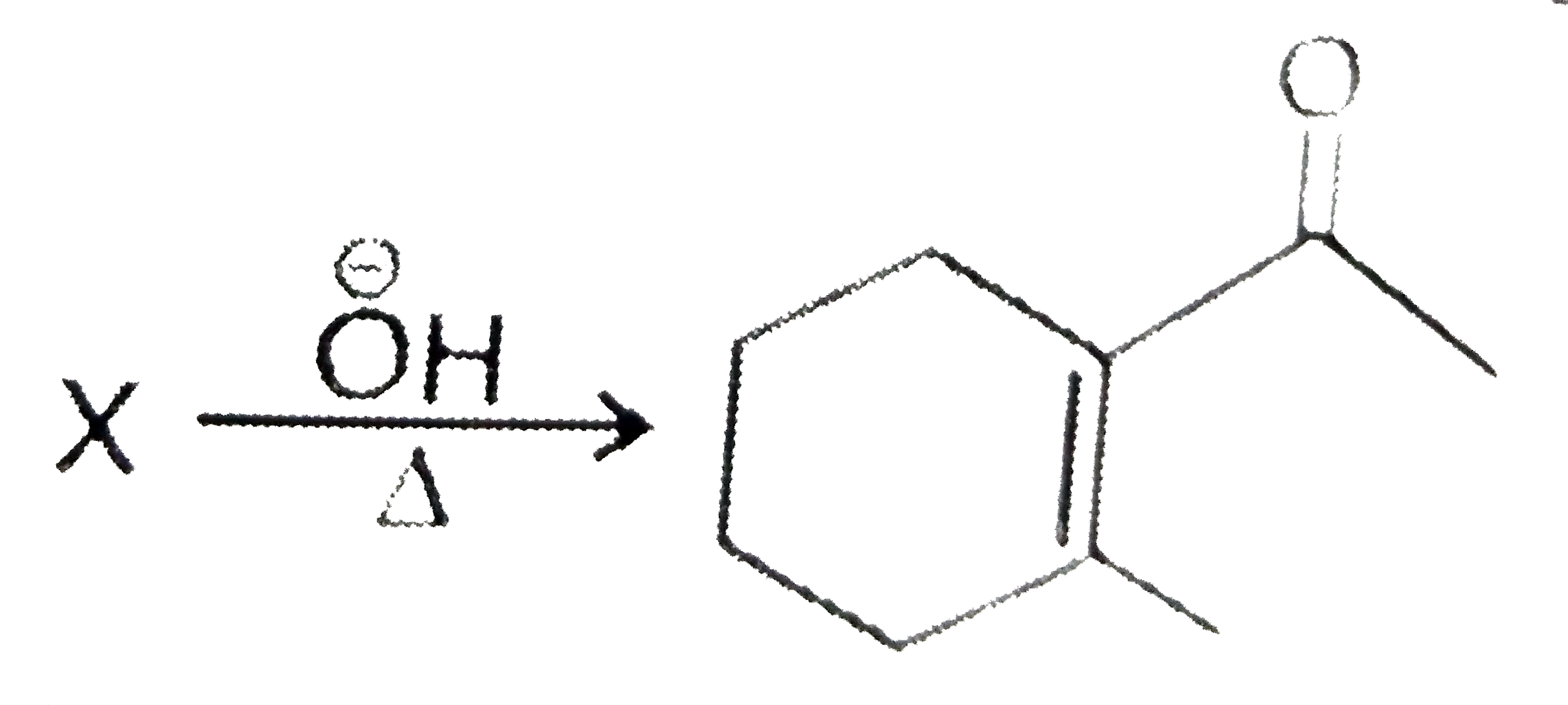
X can beView SolutionAn organic compound `X` on treatement with acidified `K_(2)Cr_(2)O_(7)` gives a compound `Y` which reats with `I_(2)` and sodium carbonate to form tri-iodomethane. The compound `X` is
03:53View SolutionWhat is the final products (B) of this reaction sequences ?
 03:04View Solution
03:04View SolutionCannizzaro reaction does not take place with
05:13View SolutionWhich of the following does not give haloform reaction:
View SolutionSynthesis of an ester involves the reaction of alcohols with
04:55View SolutionPhenyl magnesium bromide reacting with t-butyl alcohol gives
02:29View Solution
Products A of the above reactions is04:28View SolutionIn the reaction sequence
`CH_(3)-overset(O)overset(||)(C)-H-underset(.^(Θ)OH)overset(HCN)rarr(A) underset(Delta)overset(H_(2)O //overset(o+)(H))rarr` Product is/are :View Solution on reductive ozonolysis yeilds 03:36View Solution
on reductive ozonolysis yeilds 03:36View SolutionThe cyanohydrin of a carbonyl compound on hydyrolysis gives lactic acid. The carbonyl compound is
03:46View SolutionWhich of the following will not undergo aldol condensation reaction ?
01:18View Solution`PhCHO +(CH_(3)CO)_(2)O overset((1)CH_(3)COONa)underset((2)"hydrolysis", Delta)toA overset(HBr)toB B`
The product B isView SolutionWhat will be the product of the following reaction
`Ph-underset(Me)underset(|)(C)-Me overset(RCO_(3)H)to ? `View SolutionIn the following conversion

Which of the following reagents is suitable ?View SolutionThe major products formed in the reaction
`C_(6)H_(5)CHO+CH_(3)NO_(2) overset(NaOH)underset("Heat")to(X)`02:18View SolutionFor the following acids the rate of decarboxylation on heating would be
`I. CH_(6)H_(5)-overset(O)overset(||)(C)-CH_(2)-COOH " " (II) C_(6)H_(5)-overset(O)overset(||)(C)-COOH`
`III. CH_(3)-CH_(2)-COOH " " IV. HOOC-CH_(2)-COOH`View Solution`R-overset(O)overset(||)(C)-Cl overset(NH_(3))toNH_(4)Cl+(X) overset(P_(4)O_(10))underset(Delta)to(Y) overset((i) DIBAL -H)underset((ii)H_(2)O)to(Z)`
The compound (Z) isView Solution View Solution
View SolutionStarting from propanoic acid, the following reactions were carried out what is the compound Z
View SolutionWhich of the following acids remains unaffected on heating
View Solutionm-chlorobenzaldehyde on reaction with conc. KOH at room temperature gives :
View SolutionThe given reaction
 is known as : 05:21View Solution
is known as : 05:21View SolutionIn which of the following reactions benzaldehyde is the final major products
`(i) Ph-CH_(3)+CrO_(3)+(CH_(3)CO)_(2) O overset(273-283K)to overset(H_(3)O^(+))underset(Delta)to`
(ii) `Ph-CH_(3)-overset(Cl_2)underset(hv)to Ph-CHCl_(2) overset(H_(2)O)underset(100^(@)C)to`
`(iii) C_(6)H_(6) overset(CO+HCl)underset(AlCl_(3))to`
`(iv) Ph-COCl+(CH_(3))_(2)Cd to `View Solution
Part-I questions and complete solutions for chapter CARBONYL COMPOUNDS (ALDEHYDES & KETONES ) & CARBOXYLIC ACID of PHYSICAL, INORGANIC, AND ORGANIC CHEMISTRY of Class 12
